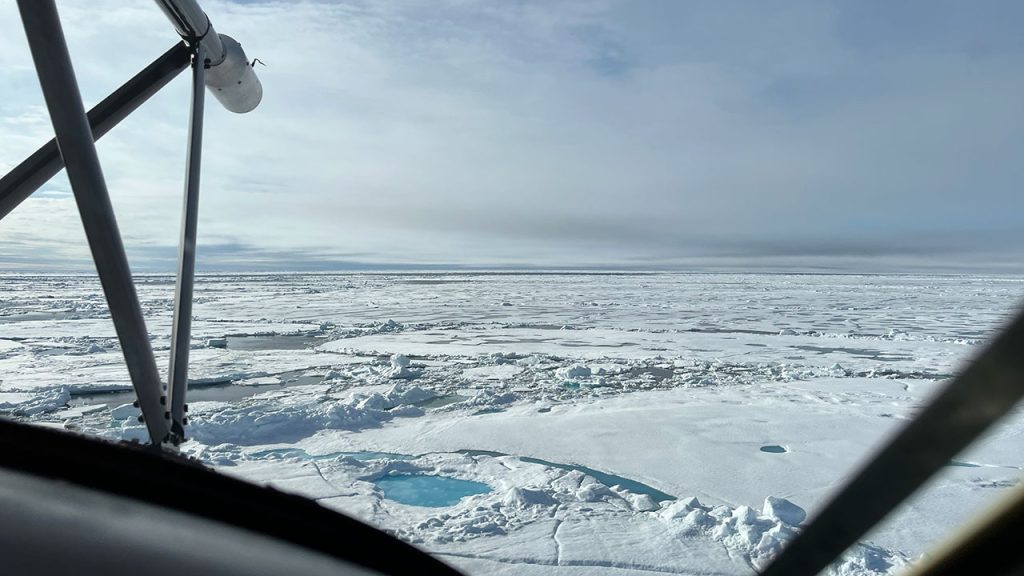
Arctic and the atmosphere
Some of the greatest impacts of human-caused climate change are being felt in the Arctic. Temperatures in parts of the Arctic are warming more than four times as fast as global temperatures.
“Arctic sea ice decline over the past 40 years is one of the most obvious signs that the Earth’s climate is warming,” says Professor Ed Hawkins, climate scientist at the National Centre for Atmospheric Science and University of Reading.
As the annual Arctic Circle Assembly starts this week, an event that brings together governments, organisations, universities, environmental associations, Indigenous communities, and citizens for Arctic-focused dialogue, we are sharing some of our atmospheric research that aims to understand climate change in the Arctic.
A mobile observatory for a changing climate
We are witnessing an alarming rate of ice sheet melt across Greenland in the Arctic. As climate change accelerates, the need for innovative and adaptive scientific solutions has never been greater.
A state of the art automated and mobile observatory – that will bridge critical air-ice observational gaps and lay the groundwork for an early warning system for ice sheet melt – is being developed by the GAMB2LE project led by the National Centre for Atmospheric Science (NCAS), in collaboration with University of Colorado Boulder, Menapia Ltd, and Polar Field Services.
Focusing on the atmosphere-ice interface, the new observatory will be optimised to continuously collect high-resolution data in even the most challenging cold environments – redefining how scientists observe and understand the climate tipping points of the Greenland Ice Sheet.
“The long-term plan will be to establish a new benchmark for automated polar research, deploy the observatory across previously inaccessible regions of the Greenland Ice Sheet, and deliver vital insights that will shape global climate strategies for years to come.” – Dr Heather Guy, Research Fellow in Polar Observational Meteorology at NCAS and the University of Leeds.
Flights uncover link between sea ice and Arctic storms
Arctic storms are the main type of hazardous weather that affect the polar environment during summer. They can impact sea ice movement, trigger rapid ice loss, measure thousands of kilometres in diameter, and persist for several days or weeks.
As a result of global warming, sea ice is becoming thinner across large areas of the Arctic Ocean in summer, year on year – making it more susceptible to storms.
NCAS scientists worked with an international research aircraft campaign to collect crucial information about the lower atmosphere and properties of sea ice across the Svalbard region. They also provided vital weather forecast interpretation to determine prime areas for investigation and to set the flight plans several days ahead.
Dr Oscar Martinez-Alvarado from NCAS, who supported flight operations, said: “Arctic cyclones are much less understood than other types of cyclones. The field campaign collected crucial information to help us improve models of our atmosphere.”
Methane monitoring for melting permafrost
As a potent greenhouse gas, methane has a significant impact on global warming. Methane emissions from thawing permafrost are a growing concern, and were the focus of a measurement campaign involving NCAS researchers in northern Sweden and the Arctic Ocean.
The NCAS-managed research aircraft facility, known as the FAAM Airborne Laboratory, was used to compare methane released from seas, soils, wildfires, and oil and gas platforms – to identify what has been causing a recent rise in atmospheric methane over the past decade.
Impacts on UK weather
Changes in the Arctic directly affect the UK’s climate and weather, and there is growing evidence that suggests changes in the Arctic will lead to more extreme weather in the UK.
The warming Arctic and rapid loss of land and sea ice will result in higher sea levels and increased risk of coastal flooding in the UK. Warming in the Arctic might also result in shifts in atmospheric circulation, such as the North Atlantic jet stream – a key driver of UK weather.
NCAS scientists are working to understand how extreme weather events will change over coming decades – their location, frequency and severity. This will be key to understanding future climate risks for the UK, and resolving the uncertainty associated with the influence of the warming Arctic is a key piece of the puzzle. The CANARI project, led by NCAS, is delivering a suite of state-of-the-art weather and climate model simulations to help understand how and why the North Atlantic – Arctic climate system is changing.
“The types of weather we expect to be affected include droughts, heatwaves, extreme winds, and storms that lead to inland and coastal flooding. But the details of these impacts, driven by Arctic warming, remain uncertain for the time being. Due to the current ability of computer models to simulate climate change and atmospheric circulation processes, it is challenging to predict short and long term changes to the Arctic environment,” explains Dr Ben Harvey, climate scientist at NCAS and the University of Reading.
